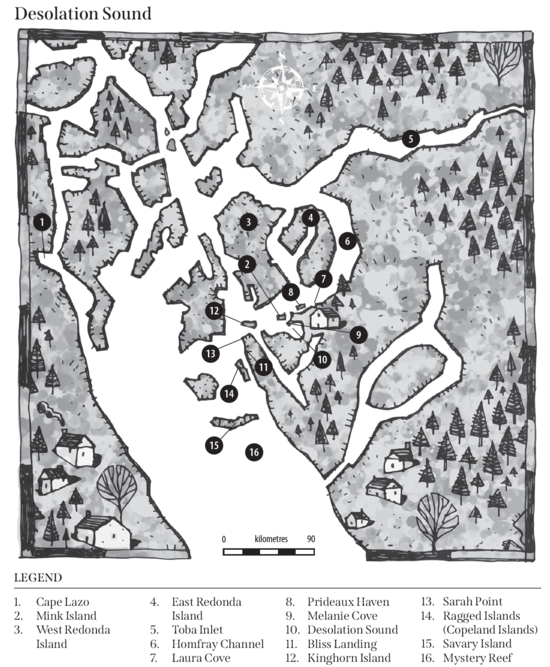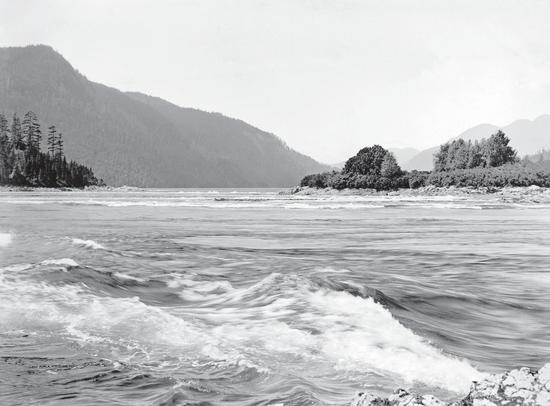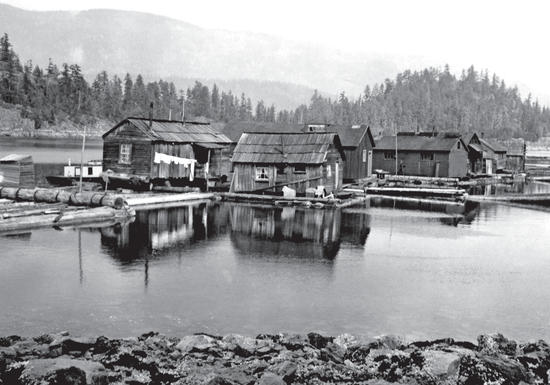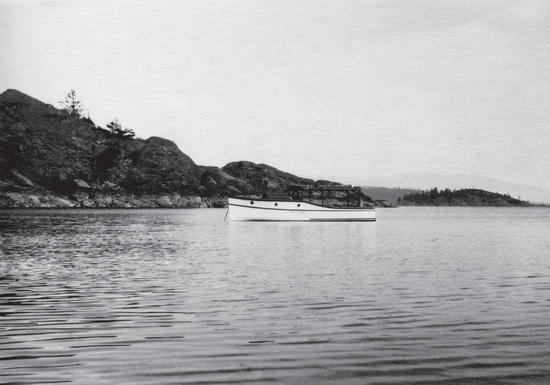Desolation
We bucked a strong tide and west wind, and ran for ten hours that day before we finally turned in by Sarah Point. From there we set a straight course for Mink Island, where there is good shelter and fresh water from a small fall.
It was good to be on land again. We made a fire on the sloping rock, and while waiting for it to burn down to embers we swam and played around in the warm water. I had just started to think about supper when a boat we knew came into the bay and presented us with a chunk of out-of-season venison. We cut it into steaks and broiled it, then ate it in our hands on big slices of bread—hoping that it would look and smell like lamb, if any unfriendly boat came into the bay.
Vancouver had named this part of the coast Desolation Sound. On their return from Jervis Inlet—tired, disappointed, and out of food—and when they turned south to rejoin their ships, they were very surprised to find two Spanish vessels at anchor off Burrard Inlet. The Sutil, under command of Senor Don Galiano, and the Mexicana, under Senor Don Valdes.
Vancouver says: “I had experienced no small degree of mortification in finding the external shores of the gulf had already been visited and examined a few miles beyond where my researches had extended.”

Later, the Discovery and the Chatham and the two Spanish vessels joined forces and sailed up Malaspina Strait together. They evidently entered Desolation Sound after dark and in the rain, and had drifted and been blown around helplessly, unable to get any soundings. Finally, they ended up on the north side of an island, where they all managed to anchor in thirty-two fathoms.
The next morning they found themselves “about half a mile from the shores of a high rocky island, surrounded by a detached and broken country, whose general appearance was very inhospitable. Stupendous rocky mountains rising almost perpendicularly from the sea principally composed the northwest, north, and east quarters.” Vancouver mentions that they could not trace the range of mountains that they had seen stretching far to the northwest of Jervis Inlet. The mountains in Desolation Sound are just on the edge of that range—as he half supposed.
The morning was fine, and their small boats were sent off exploring in all directions. But in the afternoon the wind started to blow from the southeast, attended with heavy squalls and much rain. Their anchors dragged off into eighty fathoms, and they had to heave them up and make for an anchorage and rendezvous that one of the small boats had been sent to find.
It took them until six o’clock to get the four ships safely anchored in Teakerne Arm on Redonda Island.
We cruised around the next morning, and finally found and identified their rocky island as the present Kinghorn Island. Then, never having been in Teakerne Arm, we ran up there to spend the night. We found it rather a delightful place: high rocky shores, two and three thousand feet in height, except over in one bay to the north where a waterfall leaps seventy feet down into the sea. It comes from lakes directly behind the falls, and the water is warm, with a more or less sandy beach at the foot.
The ships were anchored in there for two weeks while the small boats explored in all directions. Archibald Menzies, the botanist, says: “They rowed over to the falls every day and used it more or less like a resort.”
Captain Vancouver, who seems to have stayed on board the Discovery making up his notes and maps, was once more depressed—I suppose after finding that one more inlet, Toba, did not cut through the mountains.
He says: “Our situation here was an arm of the Sound leading to the northwest a little more than half a mile wide, presenting as gloomy and dismal an aspect as nature could well be supposed to exhibit. Our residence here was truly forlorn—an awful silence pervaded the gloomy forest while animated nature seemed to have deserted the neighbouring country, whose soil afforded only a few wild onions, some samphire, and here and there some bushes bearing a scanty crop of indifferent berries. Nor was the sea more favourable to our wants—the steep shore prevented the use of the seine, and not a fish on the bottom could be tempted to take the hook.”
Mr. Johnstone and his party had gone up to the head of Toba Inlet. On their way back they explored Prideaux Haven, a collection of small islands and coves in the northeast corner of Desolation Sound. There they found a deserted Indian village. Judging from the number of shacks they thought it must have held about three hundred persons. It was built on a high rocky peninsula with perpendicular rock sides, connected to the mainland by a narrow neck of land with a plank bridge up to the rock. The Indians had built a wooden platform on the face of the rock in front of the houses and projecting out over the sheer cliff, making it impossible for enemies to climb up. Examining this site the sailors were suddenly assailed with legions of ferocious fleas. The fleas were so bad that the men rushed up to their necks in the water to try to get rid of them. But it wasn’t until they boiled their clothes that they succeeded. They supposed that the Indians had abandoned the village on account of the fleas. In all our summers up the coast we have always found the Indian villages empty. Most of them are winter villages to which the Indians come back after being off in their dugouts all summer.

Captain Vancouver, who had been much puzzled by the tides in all these regions, as reported by his young gentlemen, came to the conclusion that they were flooding in from the north as well, which must denote open sea to the northwest. Accordingly, he sent Mr. Johnstone and his boat up to the northwest to discover where this flood-tide came from.
Mr. Johnstone worked his way through the Yaculta Rapids and all the other intricate passages; and eventually into a narrow, open passage that led him right through to Alleviation Island, from where he was able to get a clear view of the Pacific beyond. That being what he had been sent out to find, he turned back. Now, instead of all the intricate passages by which he had come north, he sailed straight down through the narrow, open passage he had found, until he reached the latitude of the ships. He cut across to them at the north end of Quadra Island.
After hearing Mr. Johnstone’s report, Captain Vancouver said good-bye to the Spaniards, and with the Discovery and the Chatham made for Cape Mudge on the south end of Quadra Island. From there they sailed up the now-called Johnstone Strait to the open Pacific. On the way they passed a village in Menzies Bay—twenty canoes filled with Indians observed to be highly painted. “The faces of some were entirely white, some red, black, or lead colour. While others were adorned with several colours. Most of them had their hair decorated with the down of young sea-fowl.” (Down in the hair was a sign of peace.)
Up at the Nimpkish River, just before they came out into the open Pacific, they visited the Indians in a large village. They were friendly, and well acquainted with white men, there being a trail from their village across Vancouver Island to Nootka on the west coast, where there was a Spanish fort and trading-post. The Indians at Nimpkish had firearms. Vancouver mentions that a number of these Kwakiutl Indians had heavy black beards—proof, I should think, that the Spaniards and Russians had been on the northwest coast for many years.
We were not exactly trying to follow Vancouver’s route—we already knew practically all the places he had been to. But we had a copy of his diary on board and we were filling in the few gaps in our knowledge. We spent a couple of nights in Teakerne Arm—the waterfall and the lake being a big attraction. Then, wanting to put in time while we waited for better tides in the Yaculta Rapids, we followed the course that Vancouver had taken with his two ships over to Cape Mudge on Quadra Island.
They went by Sutil Channel, a wide, deep channel that leads fairly directly to Quadra Island and then south to Cape Mudge.

We followed by a small-boat channel five miles farther north. The whole area lies between the Yaculta Rapids on the north—up against the mainland, and the Seymour Narrows and Discovery Passage on the south—up against Vancouver Island, covering roughly four hundred square miles. It is almost completely filled with large islands that seem to have split apart from each other like a disintegrating ice-floe, and serve as a great baffle-plate in the centre of the conflicting tides. The narrow leads in between the island have revealing names—Surge Narrows, Hole-in-the-Wall, Okisollo Channel. The narrow boat-passage that we had come through was, as the Coast Pilot had warned us, choked with drying rocks. But we knew that the local people sometimes used it if they had missed the tide in Hole-in-the-Wall. Hole-in-the-Wall is a rapid that runs from eight to ten knots, and with practically no slack it just slaps round from one direction to the other. Entrance to it is from the Yaculta side. Okisollo Channel has two rapids, and opens out from Seymour Narrows side. Surge Narrows, which is southeast of the other two, is probably the worst. The channel there turns abruptly at right angles and forces the stream, which runs at nine knots, between small islands with dangerous cross-currents. None of these, the tide-book warns, is available to other than small local boats.
It seemed to us to be a place of great risks and, probably, much luck. Yet we knew that in the winter-time the scattered people from the Yaculta district would pile their fish-boats full of people, from the smallest baby to the oldest grandmother, and work through Hole-in-the-Wall and Okisollo with the tide to attend a dance over on the Seymour Narrows side—a dance that would last until Sunday afternoon and the turn of a tide. Then, later, the Yaculta people would hold a dance in the store at Stuart Island; and from all directions, Hole-in-the-Wall, the Arran Rapids, and the Yacultas, the fish-boats would surge into the Stuart Island wharf.
We spent the whole day avoiding drying rocks, or being pushed by the tide in directions we didn’t want to go, and holing up in little bays until we could move in the direction we wanted to. It was late when the tide hurried us out of those lonely waters into Sutil Channel—deep and wide and free of rocks. We speeded up and headed for Quadra—the largest of this group of islands that plugged the channel. It is a big island—twenty miles long, and the side we were on was to the north. It seemed desolate and dreary. We turned down towards Cape Mudge where there was more chance of shelter for the night.
We were passing a very uninviting bay, grey, small firs dripping moss, a boulder shore with drift-logs at the top, when . . .
“Mummy!” said Jan, in a horrified voice. “What is that?”
We crowded over to her side of the boat to see what she was pointing at. A very large bird with a big wingspread, red head and neck, was circling low above the beach. As we watched, two more rose slowly and silently from behind the logs into the air. And then the three of them, red heads on long red necks, after peering balefully at our boat, slid silently off into the dark forest.
“There is a horrid smell!” whispered Peter.
There was—the sickly, searching smell of something very dead . . . not fish.
“What were they?” whispered Jan.
“Vultures,” I whispered.
“What?” whispered John.
“Vultures!” I shouted, to break the spell that an unknown horror had cast over us. “Just vultures.”
“I can’t bear them!” said Jan, getting back her voice. “Why didn’t they make any noise?”
“What’s a vulture?” broke in Peter.
I had never seen a vulture before. I didn’t even know there were any on the coast of British Columbia. I thought they lived in deserts. Evidently they are things that don’t need any introduction, you just guess, when you see them.
I speeded up to get away from the smell. We still had to find an anchorage for the night; we hadn’t eaten yet, and it would soon be dark.
“I see an old home in there,” said Peter presently.
I slowed down and took the binoculars from him. It seemed worth investigating. There was a small island in the bay to one side of the point where the house was. There wouldn’t be a house in this desolate place unless there was a shelter for a boat. Jan went up to the bow, and we drew in towards the little island.
Jan held out her arm and motioned, and I swung towards the left of the island, then through a narrow opening between the island and the shore. It opened out into a little bay with a beach. Both sheltered by the island—and there was enough water for anchorage. In a southeaster you might have the whole Gulf of Georgia trying to get in too—but it would do for tonight.
I couldn’t let out very much chain—there was not much room to swing. I could hardly see the brown house, lying quiet among the trees. There was no light. Was anyone listening? If we called out “Is anyone there?” would anyone answer?
I wouldn’t let the children land on the beach. They had to be content with the little island, while I cooked the supper.
I didn’t have a very good night—a breeze came up from the southeast, and we slopped a bit. I wasn’t worrying about it—but a change of any kind in the night always rouses me. But I kept thinking of the vultures and wondering what had been behind the log . . . and that wasn’t conducive to sleep. And the brown house I could no longer see, stood there, listening . . .

After breakfast we went on shore to explore. Up three or four wooden steps from the beach; then along a gravel path bordered on both sides by lilac bushes. There had once been lawns, and neglected flower-beds circled the house. A verandah ran round three sides reached by a flight of steps. We skirted round to the other side. Here the lawn sloped steeply to the sea, and there was a ground-floor room with door and windows. The door stood open, so we looked in. A kitchen stove stood there, chairs, and a dining-table. On the table, a plate with a knife and a piece of bread. Had someone taken to the woods when they heard our boat?
We backed out cautiously and, with one eye on the woods, went round the house and up the steps onto the verandah. There was no glass in any of the windows, but each one was securely covered with small-mesh chickenwire. I first thought that someone must have used the house for chickens. But looking through a window I saw that the wire hadn’t been for chickens. There were odds and ends of furniture, and the floor was littered with torn letters and pamphlets, otherwise quite clean. I tried the one door, and it opened. We went in . . . The windows at the back of the house were covered with the wire too. Someone had evidently been trying to keep something either in or out—but which, or what?
I picked up a couple of pamphlets from the floor. They were all about the life of the spirit after death, and how to get into communication, published by some society of psychical research. Most of the torn letters were written by people of education. Then I found some pages from a diary, written just the last winter. It fooled me at first—it was rather beautiful, rather like James Joyce in parts. Then suddenly, some sentence made me realize that the mind of the writer was on a very, very strange plane . . .
I had straightened up—thinking that I would take the pages with me and read them later, away from the “heavy, heavy hangs over your head” atmosphere—when I noticed a framed picture on the wall, a picture of someone wrapped in white lying on a couch. Above the wrapped figure hovered a strange white cloud of vapour. Underneath was written, “Authentic photograph of spirit leaving body after death.”
I left, opening the door only a little, and shutting it quickly behind me. I knew now the reason for the wire—the diarist had been trying to keep something he had trapped in there from getting out.
